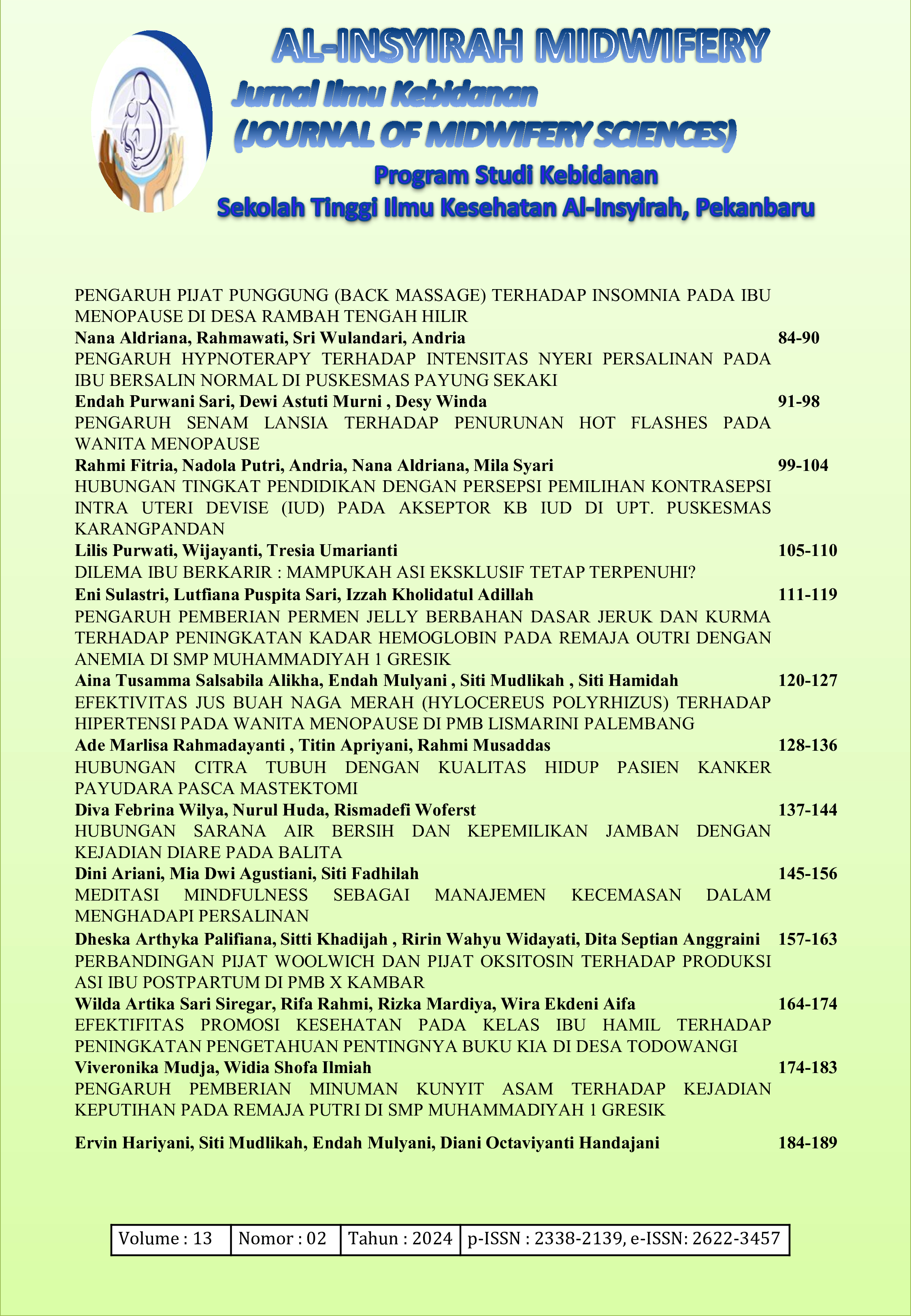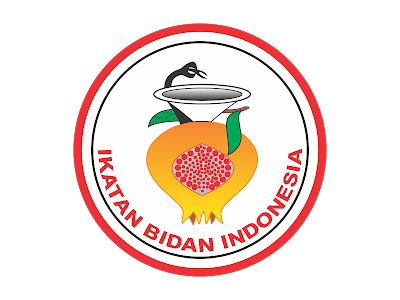HUBUNGAN SARANA AIR BERSIH DAN KEPEMILIKAN JAMBAN DENGAN KEJADIAN DIARE PADA BALITA
DOI:
https://doi.org/10.35328/kebidanan.v13i2.2755Keywords:
Diarrhea, Toddlers, Clean Water Facilities, Toilet OwnershipAbstract
Diarrhea is the second leading cause of mortality in Indonesia. Batang Tarang Community Health Center located in Balai Sub-district, Sanggau Regency in 2023 there were 283 cases of diarrhea with 2 deaths. Clean water facilities and ownership of latrines that do not meet the requirements can be a cause of diarrhea. The purpose of this study was to determine the relationship between clean water facilities and latrine ownership with the incidence of diarrhea in toddlers. This quantitative research with case control study research design. Data was collected using a checklist and observation. The population of this study were toddlers who had diarrhea and sought treatment at the Batang Tarang Health Center in July-December 2023 as many as 283 people. The sampling technique used quota sampling. The sample of 148 people consisted of 74 cases and 74 controls. Univariate data analysis with frequency distribution table, bivariate analysis using chi-square test. The characteristics of the respondents were mostly 20-35 years old with secondary education, the majority of toddlers aged 25-59 months, the most female gender. The majority of clean water facilities and latrines do not meet the requirements. The results of bivariate analysis there is a relationship between clean water facilities and the incidence of diarrhea (p value 0.001) and there is a relationship between latrine ownership and the incidence of diarrhea (p value 0.001). Based on the research, it can be concluded that there is a relationship between clean water facilities and latrine ownership with the incidence of diarrhea in toddlers
Downloads
References
Chandra, F., Junita, D.D. and Fatmawati, T.Y. (2019) ‘Tingkat Pendidikan dan Pengetahuan Ibu Hamil dengan Status Anemia’, Jurnal Ilmiah Ilmu Keperawatan Indonesia, 9(04), pp. 653–659. Available at: https://doi.org/10.33221/jiiki.v9i04.398.
Dinas Kesehatan Provinsi Kalimantan Barat (2023) Profil Kesehatan Kalimantan Barat 2022. Pontianak: Dinas Kesehatan Provinsi Kalimantan Barat. Available at: https://datacloud.kalbarprov.go.id/index.php/s/PLjw5737Xy5yz4P#pdfviewer.
Dinas Kesehatan Sanggau (2023) Laporan Kesehatan Anak Kab. Sanggau Desember 2023. Sanggau.
Fitriani, N., Darmawan, A. and Puspasari, A. (2021) ‘Analisis Faktor Risiko Terjadinya Diare Pada Balita Di Wilayah Kerja Puskesmas Pakuan Baru Kota Jambi’, Medical Dedication (medic) : Jurnal Pengabdian kepada Masyarakat FKIK UNJA, 4(1), pp. 154–164. Available at: https://doi.org/10.22437/medicaldedication.v4i1.13472.
Gultom, R. and Khairani (2021) ‘Evaluasi Kepatuhan Pasien Anak Penderita Diare Terhadap Penggunaan Antibiotik Di Rumah Sakit Umum (Rsu) Karya Bakti Ujung Bandar Rantauprapat’, JIFI (Jurnal Ilmiah Farmasi Imelda), 4(2), pp. 37–42. Available at: https://doi.org/10.52943/jifarmasi.v4i2.531.
Iswandi, A.I. et al. (2023) Rencana Aksi Nasional Penanggulangan Pneumonia dan Diare Indonesia 2023-2030, Kementerian Kesehatan. Jakarta: Kementerian Kesehatan Republik Indonesia. Available at: https://p2p.kemkes.go.id/wp-content/uploads/2023/12/NAPPD_2023-2030-compressed.pdf (Accessed: 5 February 2024).
Katiandagho, D. and Darwel, D. (2019) ‘Hubungan Penyediaan Air Bersih dan Jamban Keluarga Dengan Kejadian Diare Pada Balita Di Desa Mala Kecamatan Manganitu Tahun 2015’, Jurnal Sehat Mandiri, 14(2), pp. 64–78. Available at: https://doi.org/10.33761/jsm.v14i2.118
Kementerian Kesehatan RI (2022) Buku Bagan Manajemen Terpadu Balita Sakit. Jakarta: Kementerian Kesehatan Republik Indonesia
Maywati, S., Gustaman, R.A. and Riyanti, R. (2023) ‘Sanitasi Lingkungan Sebagai Determinan Kejadian Penyakit Diare pada Balita di Puskesmas Bantar Kota Tasikmalaya’, Gorontalo Journal Health and Science Community, 7(2), pp. 219–229. Available at: https://ejurnal.ung.ac.id/index.php/gojhes/index
Mujiyanto, M. and Muhammad, A. (2022) ‘Analisis Kualitas Air Sumur di Sekitar Kampus Universitas Islam Indonesia’, Indonesian Journal of Laboratory, 5(3), p. 105. Available at: https://doi.org/10.22146/ijl.v5i3.79095.
Noventi, D., Umboh, J.M.L. and Sumampouw, O.J. (2023) ‘Sarana Air Bersih dan Jamban Keluarga pada Balita Penderita Diare Anak Berumur Bawah Lima Tahun (Clean Water Facilities and Family Latrines for Children Under Five Years Old with Diarrhea)’, Jurnal perempuan dan anak Indonesia, 4(2), pp. 69–82. Available at: https://doi.org/10.35801/jpai.4.2.2022.44111.
Permana, B. et al. (2020) ‘Analisis Sifat Fisika dan Derajat Keasaman terhadap Kualitas Air Minum Isi Ulang 20 Rumah RW 01 di Kampung Cilember Desa Jogjogan Kecamatan Cisarua Kabupaten Bogor’, Risenologi, 5(1), pp. 64–69. Available at: https://doi.org/10.47028/j.risenologi.2020.51.82.
Rahmadani, N. and Mustari, S. (2021) ‘Analisis Sanitasi Dasar dan Tindakan Masyarakat Tentang Kesehatan Lingkungan di Kecamatan Batang’, Jurnal Mitra Sehat, 11, pp. 304–314. Available at: https://journal.stikmks.ac.id/index.php/a/article/view/301/211
Rahmatillah, N., Abdullah, A. and Arlianti, N. (2023) ‘Faktor-Faktor Yang Berhubungan Dengan Pemanfaatan Jamban Umum Oleh Masyarakat Di Wilayah Kemukiman Lamteuba Kecamatan Seulimuem Kabupaten Aceh Besar’, Jurnal Kesehatan Tambusai, 4(4), pp. 4988–4995. Available at: https://doi.org/10.31004/jkt.v4i4.19920.
Yantu, S.S., Warouw, F. and Umboh, J.M.L. (2021) ‘Hubungan antara Sarana Air Bersih dan Jamban Keluarga dengan Kejadian Diare pada Balita di Desa Waleure’, Jurnal KESMAS, 10(6), pp. 24–30.
Downloads
Published
Issue
Section
License
Copyright (c) 2024 Al-Insyirah Midwifery: Jurnal Ilmu Kebidanan (Journal of Midwifery Sciences)

This work is licensed under a Creative Commons Attribution 4.0 International License.














